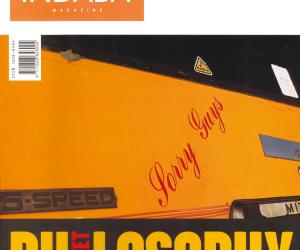First Published in

It occurred to me that the more impactful and the more artful the documentary image, the more it questions its own value. In short, the better the 'photojournalism' is as an image that will get a response from the viewer, the worse it is as a document.
Let me explain first with a little context to this thought.
Making pictures is a fundamental activity. It is a basic tool for us to communicate with, to comment on the world around us, and to analyse what it means to be human. From cave paintings to the television broadcasts, advertising billboards and art galleries of today, the image plays an essential part in our lives. I am sure this will come as no surprise to readers of this magazine.
What may be a little more challenging is to consider the role that this urge to 'picture making' has in the meaning of photojournalism. The power of documentary photography to frame or change the way we see the world is clear, indeed celebrated.
Most photojournalism exists at the level of the humdrum, the everyday picture in the newspaper or magazine where you understand the terms of reference. You accept that the picture on the front page shows the president giving an important speech; you believe this is the car that was recalled because of a technical fault; you do not question the caption that tells you that this horse and this rider won a big race yesterday.
It is as photojournalism gets more interesting, as we start looking at the really powerful images, that it becomes more difficult to accept the images as documents. Instead, they are created and are selected to make a statement that goes beyond the transparent observation of mere objects or subjects in space.
The more impactful the image, the more it suggests something beyond the simple record of an event or a thing. Indeed, the more it becomes a fiction, giving a heavily loaded interpretation of the world and working as a kind of visual poem.
Thoughts like these rushed through my mind as I applauded Luc Delahaye receiving a prize for his recent book on life in Russia, poverty post-Communism. They are photographs of disturbing subjects - made all the more disturbing by being shot in rich color. While you might be ready and aware of the photojournalist's frame of gritty black-and-white, to see such grim subjects carefully composed as lush color images converts them to being somehow more painterly, more illustrative, less documentary.
I was fortunate to be sitting next to the Canadian photographer Roger LeMoyne, himself a regular prizewinner for his intensely observed stories on Kosovo and other trouble spots around the world. We fell to discussing how photojournalism achieves this strange painting-like quality that removes it from the conventions of the documentary.
We continued the conversation the next day with Roger showing me some of his pictures, and making me realise that there is a strange connection point where great photojournalism and great painting reach the same compositional point. In effect, some of our greatest photojournalism achieves a presentation of life that locks on to the same compositional devices to capture human expression that it achieves an uncanny synergy with great figurative art. So we have compositions of grieving families in war-torn situations where the participants look like they are in a religious painting, or we have desperate crowds in a famine looking like a mass seeking spiritual enlightenment. Perhaps this is not so peculiar. What I see here are the same forces of picture making coming together. We can presume that Michelangelo arranged his models in a particular composition, with light falling across them 'just so', in order to elicit a particular emotional response from the viewer. The same thing happens when a great photojournalist shoots roll after roll of film while recording events. As they do this, they make choices to seek out certain compositions and they alight on certain moments as being particularly opportune to release the shutter. The moments that really 'work' for them (and us) when it comes to editing the shots, are those that elicit the greatest emotional response.
In effect, the great painter and great photojournalist come from different directions to arrive at the same key moments of human passion, of imagery that communicates deep within us and elicits our strongest responses. Our reactions to expressions of grief, or 'god light' falling through an open window, have probably not changed over time. Is it possible that our image-makers, whether seeking to create art or to document reality, inevitably end up in the same visual zone, using the same devices to connect with the viewer?
There is something else at play here, of course. The very subjects of the documentary lens - the grieving people, etc. - are they also arranging themselves in the image of great art? I think this could also be the case. Cultural conditions can form us, even in the most extreme situations, to behave in certain forms. Gathered around a coffin, we display stoicism or suffering in time-honoured fashion. Watching our team win a football match, I suspect we also display similar behaviour the world over, and similar to that displayed at some earlier victory celebration.
This theory of the connection between, say, religious art from the Renaissance and contemporary colour photojournalism now comforts me a little. I feel less suspicious of the manipulations of reportage as the searing images reach for my emotions. I accept the power of the messages and sense I am manipulated with my eyes open. Of course, I could just be falling for the deeper fix of the complexly woven political messages within the images and the artistry. That remains in the photojournalist's hands.
By way of illustrating the theory above, I feel I can do no better than show Lara Jo Regan's first-placed image in the recent World Press Photo awards. It shows a Mexican family at home in Texas. The lighting is straight out of an 'Old Master' painting, and it is this light and colour along with the classical composition of figures looking expectantly out of frame that makes an insignificant group majestic.
This immigrant family is labeled 'The Uncounted.' Uncounted because they are literally off the census and best left invisible to political factions on both sides in the argument. How many people in South Africa today could similarly be numbered, if for different reasons to the Mexicans / non-Texans? How many do not correspond to the approved vision of a model South African citizen? How many are straight out lacking an identity document? And how would you photograph them to be 'true'?
It is a challenge we all face, every day - how not to lie when we see the world. If we are professional communicators, entrusted to work around the reality and the dreams of others - through editorial, design or advertising - then the challenge is at a different level. What we do makes a difference: we inform or we mislead on a large scale.
I don't think there is an easy answer to getting it right. The beginning is to see that there is a problem. There is an endless challenge, a questioning that never ceases, in trying to depict the documentary and the underlying subjectivity.
In essence, I am saying there is an inescapable Romanticism about great photojournalism. It is imbued with a commentary that aims to move us emotionally with sheer visual power. There is nothing wrong with such Romanticism. You just need to see it and declare it. And be sure to push it. Romanticism must always be revolutionary, not nostalgic. In the latter way lies perpetuation of the problems it recognises.
Here ends the sermon. It's hard work to express and change tough reality by image making. But hard work is the only option.Lewis Blackwell is in charge of creative direction at Getty Images, the world's leading provider of still and moving imagery for design, advertising and editorial. Among the brands whose content Lewis leads are Stone, The Image Bank and PhotoDisc. He is a critically acclaimed and best selling author on communication, with books including The End Of Print, 20th Century Type and the upcoming Soon. He teaches and also lectures widely and chaired the 4th International Design Indaba in 2001.




